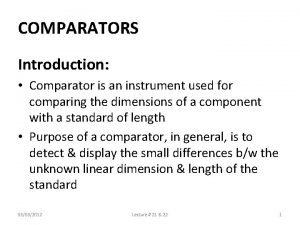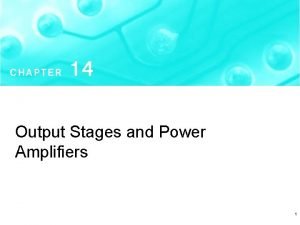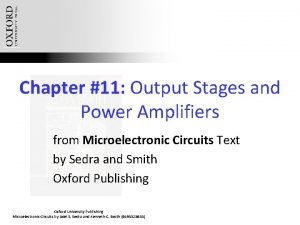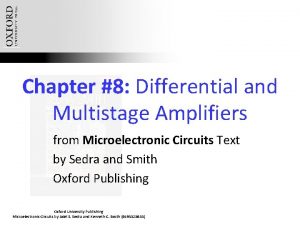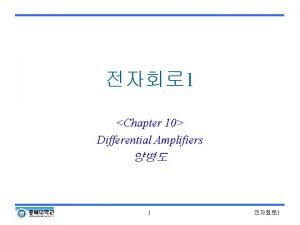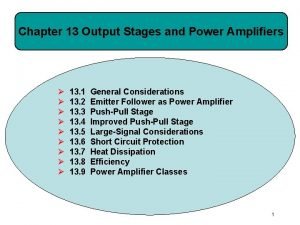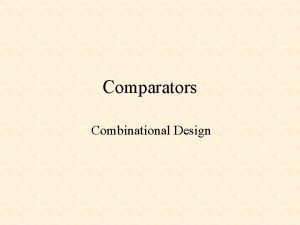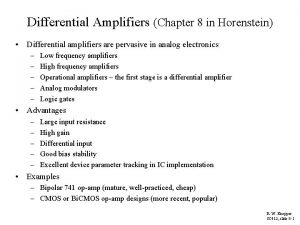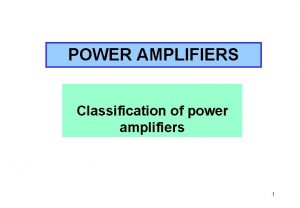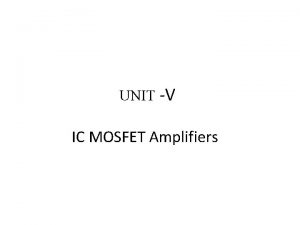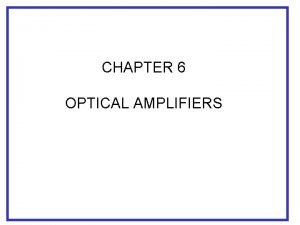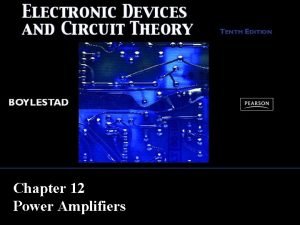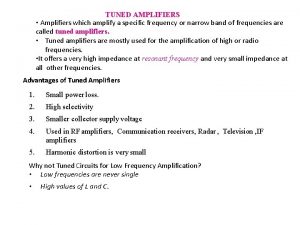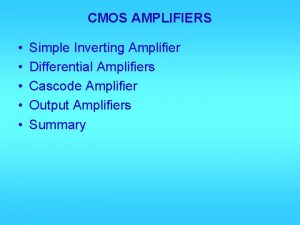Lecture 10 Amplifiers and Comparators Today we will












- Slides: 12

Lecture 10: Amplifiers and Comparators Today, we will n Learn how to design op-amp circuits to perform a task ¨ Piece together basic op-amp circuits and adjust resistances ¨ D/A converter n Investigate another digital application of the op-amp: the comparator ¨ 1 -bit A/D converter V 0 V+ + V

Designing Op-Amp Circuits n n n You can design a new op-amp circuit by connecting our basic op-amp circuits together and selecting resistor values. Even if there is an element (or another circuit) attached to the output of an op-amp circuit, the op-amp circuit behaves the same. Break the desired task into smaller pieces which are easily done with one op-amp circuit, then connect the circuits together.

Example n Design a circuit whose output is:

Number Representation n n A computer represents the number “ 1” (logic 1) by some positive voltage; usually 3 V to 5 V. The number “ 0” is represented by 0 V. A number in the computer is stored in binary, or base two representation. Each binary digit (bit) is represented by a voltage at a separate point. V 2 Memory Chip V 1 V 0 3 -bit memory

Number Representation n In the circuit below, V 0 could represent the “ones” place, V 1 the “twos” place, and V 2 the “fours” place. One can have either a 1 or a 0 in each place. So, the 3 -bit memory can store numbers 0 through 7. The number in each place is represented by a voltage, 0 V for 0 and, say, 5 V for 1. V 2 Memory Chip V 1 V 0 3 -bit memory

Digital to Analog (D/A) Conversion n n The op-amp circuit that we just designed converts the digital number representation in our memory chip to an analog representation. It takes a number currently represented by three voltages with place values, and reinterprets the number so that “ 1” is represented by 1 V, “ 6” is represented by 6 V, etc. The circuit: ¨ Divides each input voltage by 5 so each will have the value 0 V or 1 V ¨ Multiplies by the place value that number represents ¨ Adds up the numbers

D/A Conversion n n Your stereo speaker has cones in it that vibrate to make the sound. An analog voltage causes the cones to vibrate. The D/A converter helps translate digitally stored music into an analog voltage for the speakers. Digital music (CD, MP 3) provides a number indicating the sound amplitude at each sample time. These numbers get translated into analog voltage by the D/A converter. The more bits used to store each sample, the more audio levels represented (better quality)

A/D Conversion, Signal Degradation n n Naturally, we want to be able to go in the other direction as well, and convert analog representation to digital. This is useful not only in audio and data acquisition, but within digital computation as well. As a digital signal propagates, it is degraded by natural resistance and capacitance in circuits. Pretty soon, the signal is not only 0 or 1 most of the time, but has in-between (nonsense) voltages too. Always 0 or 1 Degraded Signal

Comparator The degraded signal can be “cleaned up”, transformed into a signal which is nearly always 0 or 1, using a comparator. To make a comparator, VIN n We set the high rail on the op-amp to the logic 1 voltage, and the low rail to logic 0 (0 V). n We set the threshold voltage VTHR to be around halfway between logic 0 and logic 1. + V 0

Using the Rails n n n Note that in the linear region, VO = A (VIN – VTHR). Since A is large, the amplifier will hit the top rail when VIN is just a little above VTHR. It will hit the low rail when VIN is just a little lower than VTHR. Only a small range of VIN will leave it in the linear region. The comparator “decides” whether VIN is logic 0 or logic 1. VIN + V 0 Slope is A

Example n Suppose we have a comparator with: ¨ Logic 1 voltage = 5 V ¨ Logic 0 voltage = 0 V ¨ Threshold voltage = 2 V ¨ Ri = ∞, RO = 0 Ω, A = 1000 n For the input signal VIN(t) = 5 – e-2 t V, sketch VO(t) for t between 0 and 3 seconds.

2 -Bit A/D Converter (with rounding)
 Optical amplifiers lecture notes
Optical amplifiers lecture notes Comparators python
Comparators python Comparator instrument
Comparator instrument If statement verilog
If statement verilog Comparators are useful testing utilities
Comparators are useful testing utilities Vbe multiplier class ab
Vbe multiplier class ab Differential and multistage amplifiers
Differential and multistage amplifiers Class b amp
Class b amp Differential and multistage amplifiers
Differential and multistage amplifiers Differential and multistage amplifiers
Differential and multistage amplifiers Output stages and power amplifiers
Output stages and power amplifiers 01:640:244 lecture notes - lecture 15: plat, idah, farad
01:640:244 lecture notes - lecture 15: plat, idah, farad For todays meeting
For todays meeting


